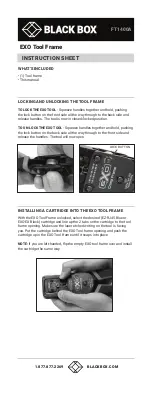
9
includes the control and replacement of carbon
brushes and grease in reducing gear housing. Take
the tool to an authorized service centre.
x
Keep the tool and supply cord clean. Keep ventilation
slots clean and open. Wipe the surface of the tool with
a soft cloth!
!
It is not allowed to use household cleaning agents
that contain petrol, trichloroethylene, ammonia
and chlorides. These substances corrode and
damage plastic parts of the tool.
x
Excessive sparking generally indicates the presence
of dirt in the motor or abnormal wear on the carbons.
!
Ventilation slots must be cleaned regularly. Clean
them with a brush or compressed air.
!
The connecting part between the guard and the
guard holder must be regularly lubricated with
non-inflammable grease.
!
In case of electric or mechanical failure, send the
tool to a Perles authorized service centre for
repair.
SERVICING AND REPAIRS
If servicing is required, contact one of our listed service
centres. It is forbidden and dangerous to perform any
individual work on the tool.
!
Have the tool repaired by authorized persons.
In case you buy spare parts in a shop, contact an
authorized service centre and have them assembled. In
case of non-compliance with the operating instructions
and instructions regarding servicing and repairs, the
producer is not held responsible for the damage caused
on property or personal injuries, and the user looses all
rights to guarantee.
!
Any repairs of the tool in unauthorized service
centres is performed at own responsibility.
!
The owner of the tool is responsible for all works
on the tool that were not performed in authorized
service centres, and therefore he looses the claim
for guarantee.
WASTE DISPOSAL AND
ENVIRONMENT PROTECTION
The machine, accessories and packaging
should be sorted for environmental-friendly
recycling.
Only for EC countries
:
!
Do not dispose of power tools into
household waste
!
According the European Guideline 2002/96/EC
for Waste Electrical and Electronic Equipment
and its implementation into national right, power
tools that are no longer usable must be
collected separately and disposed of in an
environmentally correct manner
INSTRUCTIONS GENERALES
DE SECURITE
ATTENTION! Lisez toutes les
instructions.
Le
nonrespect des instructions indiquées ci-après peut
entraîner un choc électrique, un incendie et/ou de graves
blessures sur les personnes. La notion d’«outil
électroportatif» mentionnée par la suite se rapporte à des
outils électriques raccordés au secteur (avec câble de
raccordement).
GARDEZ PRECIEUSEMENT CES INSTRUCTIONS DE
SECURITE.
1) PLACE DE TRAVAIL
a)
Maintenez l’endroit de travail propre et bien
éclairé.
Un lieu de travail en désordre ou mal éclairé
augmente le risque d’accidents.
b)
N’utilisez pas l’appareil dans un environnement
présentant des risques d’explosion et où se
trouvent des liquides, des gaz ou poussières
inflammables.
Les outils électroportatifs génèrent des
étincelles risquant d’enflammer les poussières ou les
vapeurs.
c)
Tenez les enfants et autres personnes éloignés
durant l’utilisation de l’outil électroportatif.
En cas
d’inattention vous risquez de perdre le contrôle sur
l’appareil.
2) SECURITE RELATIVE AU SYSTEME ELECTRIQUE
a)
La fiche de secteur de l’outil électroportatif doit
être appropriée à la prise de courant. Ne modifiez
en aucun cas la fiche. N’utilisez pas de fiches
d’adaptateur avec des appareils avec mise à la
terre.
Les fiches non modifiées et les prises de
courant appropriées réduisent le risque de choc
électrique.
b)
Evitez le contact physique avec des surfaces
mises à la terre tels que tuyaux, radiateurs, fours
et réfrigérateurs.
Il y a un risque élevé de choc
électrique au cas où votre corps serait relié à la terre.
c)
N’exposez pas l’outil électroportatif à la pluie ou à
l’humidité.
La pénétration d’eau dans un outil
électroportatif
augmente le risque d’un choc
électrique.
d)
N’utilisez pas le câble à d’autres fins que celles
prévues, n’utilisez pas le câble
pour
porter
l’appareil ou pour l’accrocher ou encore pour le
débrancher de la prise de courant. Maintenez le
câble éloigné des sources de chaleur, des parties
grasses, des bords tranchants ou des parties de
l’appareil en rotation.
Un câble endommagé ou
torsadé augmente le risque d’un choc électrique.
e)
Au cas où vous utiliseriez l’outil électroportatif à
l’extérieur,
utilisez une rallonge autorisée
homologuée pour les applications extérieures.
L’utilisation d’une rallonge électrique homologuée pour
les applications extérieures réduit le risque d’un choc
électrique.










































